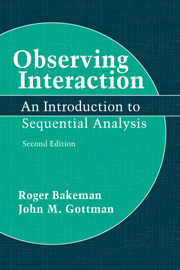Book contents
- Frontmatter
- Contents
- Preface to the second edition
- Preface to the first edition
- 1 Introduction
- 2 Developing a coding scheme
- 3 Recording behavioral sequences
- 4 Assessing observer agreement
- 5 Representing observational data
- 6 Analyzing sequential data: First steps
- 7 Analyzing event sequences
- 8 Issues in sequential analysis
- 9 Analyzing time sequences
- 10 Analyzing cross-classified events
- 11 Epilogue
- Appendix: A Pascal program to compute kappa and weighted kappa
- References
- Index
Preface to the first edition
Published online by Cambridge University Press: 13 October 2009
- Frontmatter
- Contents
- Preface to the second edition
- Preface to the first edition
- 1 Introduction
- 2 Developing a coding scheme
- 3 Recording behavioral sequences
- 4 Assessing observer agreement
- 5 Representing observational data
- 6 Analyzing sequential data: First steps
- 7 Analyzing event sequences
- 8 Issues in sequential analysis
- 9 Analyzing time sequences
- 10 Analyzing cross-classified events
- 11 Epilogue
- Appendix: A Pascal program to compute kappa and weighted kappa
- References
- Index
Summary
Sometimes even a rather lengthy series of thoughts can be associated in memory with a single, dominant image. For me (RB), when I reflect on the writing of this book, the image of Mount Rainier, seemingly floating on the late afternoon haze, is never far from my mind. This is a personal image, of course, but it is understandable if I explain that John Gottman and I first met at a conference, organized by Jim Sackett, held at Lake Wilderness in Washington State. Thus some of the conversations that laid the groundwork for this book took place against the backdrop of Mount Rainier, dominating the horizon at the other end of the lake.
The conference was concerned with the Application of Observational/Ethological Methods to the study of Mental Retardation, a title that suggests both some of the research traditions that have influenced our writing and some of the kinds of readers who might find this book useful. Throughout this century, some of the most systematic and productive observers of social interaction have been ethologists, especially those concerned with primates, and developmental psychologists, especially those concerned with infants and young children.
Although students of primate and children's behavior have been largely responsible for the development of systematic observational methods, they are not the only kinds of researchers who want to study social behavior scientifically. Among others, this book should interest investigators in all branches of animal behavior, in anthropology, in education (including those concerned with classroom evaluation as well as early childhood education), in management, in nursing, and in several branches of psychology (including child, community, developmental, health, organizational, and social), as well as investigators concerned with mental retardation.
- Type
- Chapter
- Information
- Observing InteractionAn Introduction to Sequential Analysis, pp. xi - xivPublisher: Cambridge University PressPrint publication year: 1997



